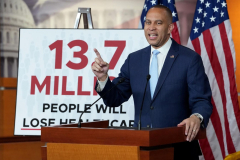
WASHINGTON, DC – MAY 13: U.S. House Minority Leader Hakeem Jeffires (D-NY) holds a press conference at the U.S. Capitol. Jeffries spoke out against the Republican budget bill and the potential cuts to safety net programs including Medicaid. (Photo by Kevin Dietsch/Getty Images)
Getty Images
Senator Jon Ossoff (D-GA) issued a press release last month stating that St. Mary’s Sacred Heart Hospital in Northeast Georgia is ending services for delivering mothers and newborn babies due to Medicaid cuts in the One Big Beautiful Bill signed into law by President Trump. This is now the second rural hospital in Georgia to reduce or anticipate cutting services, reportedly as a result of the legislation.
Established in 1965, Medicaid is the joint state and federal health insurance program largely for people with low incomes in the United States. Currently, approximately 72 million people are enrolled. It’s hard to overstate the program’s importance. It covers more than 40% of all births in the country, and nearly two-thirds of nursing home stays. Around 27 million children receive Medicaid benefits. And in the 41 states that expanded the program as part of the Affordable Care Act, it also insures millions of Americans with incomes just above the federally defined poverty line.
The OBBB requires states to condition Medicaid eligibility for adults in the ACA Medicaid expansion group at application and to institute work requirements starting Jan. 1, 2027, with the option for states to implement requirements earlier. Forty states, along with the District of Columbia, have expanded Medicaid eligibility to nonelderly adults with incomes up to 138% of the federal poverty level. In these states, Medicaid beneficiaries could lose health insurance if they cannot find work, are unable to document the required number of hours they work or cannot document an exemption. Specifically, Medicaid enrollees ages 19 to 64 must engage in at least 80 hours per month of community engagement activities. This can include work, volunteering or enrollment in an educational program. The law exempts caregivers of dependent children under age 14, persons with disabilities and pregnant women.
Estimates vary, but the OBBB could cause anywhere between 11 and 16 million Medicaid and ACA beneficiaries to lose coverage. In turn, these coverage losses will affect hospitals by reducing their revenue and increasing uncompensated care costs.
Families USA forecasts 55 additional rural hospitals newly at risk of closure as a result of Medicaid cuts. And a Brown University analysis projects close to 600 nursing homes at elevated risk of closure over the next ten years.
Medicaid has traditionally provided a “financial lifeline” for rural healthcare providers, including hospitals. But even prior to the signing of the OBBB, such providers were under substantial financial duress. KFF Health News details how for years states have been working to close budget shortfalls and have often targeted one of their biggest cost items, Medicaid. As a reminder, unlike the federal government states may not run budget deficits. This means state government must balance the books. To do so, they often must cut back on spending, for instance, by reducing pay for healthcare providers.
Nearly 50% of all rural hospitals already have negative margins, with several hundred that faced immediate risk of closure prior to passage of OBBB. Since 2005, close to 200 rural hospitals across the country have closed or discontinued inpatient services.
The One Big Beautiful Bill exacerbates an already existing problem by decreasing federal spending on Medicaid by about $1 trillion over the next decade. The law does include a $50 billion fund for rural hospitals, but policy experts say it’s not enough to offset the Medicaid cuts. Hospitals operating on thin margins are therefore at heightened risk of closing or cutting services.
Consider, for example, the Manning’s Recovery Center in Iowa. It is invariably at capacity. More than 70% of its patients are covered by Medicaid. This makes the healthcare facility especially vulnerable to cuts.
And Providence health system in Washington state may soon have to shut clinics, therapy and rehabilitation programs across two counties, citing “multiple pressures,” including state and federal Medicaid cuts and higher costs due to continued inflation.
The Commonwealth Fund recently published an issue brief in which it examined the impact of cuts to Medicaid on both hospital revenues—especially for rural and safety-net hospitals that are already struggling—and recoupment of hospital costs for services that neither insurers nor patients end up c





